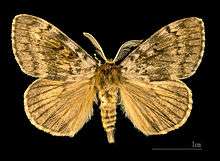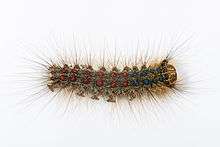Lymantria dispar
Lymantria dispar, the gypsy moth, is a species of moth in the family Erebidae. Lymantria dispar covers many subspecies, subspecies identification such as L. d. dispar or L. d. japonica leaves no ambiguity in identification. Lymantria dispar subspecies have a range which covers in Europe, Africa, Asia, North America and South America.
| Gypsy moth | |
|---|---|
 | |
| Mounted Lymantria dispar dispar male | |
_Female_Dos.jpg) | |
| Mounted Lymantria dispar dispar female | |
| Scientific classification | |
| Kingdom: | Animalia |
| Phylum: | Arthropoda |
| Class: | Insecta |
| Order: | Lepidoptera |
| Superfamily: | Noctuoidea |
| Family: | Erebidae |
| Genus: | Lymantria |
| Species: | L. dispar |
| Binomial name | |
| Lymantria dispar | |
| Synonyms | |
| |

It is listed as 100 of the World's Worst Invasive Alien Species.
Subspecies
| Common name | Subspecies | Distribution | Identifying characteristics |
|---|---|---|---|
| European gypsy moth | Lymantria dispar dispar | Europe, western Asia and north Africa[1]:6 | Females winged but flightless[1]:6 |
| Asian gypsy moth | Lymantria dispar asiatica | Eastern Asia,[1]:6 western North America[2] | Flying females; attracted to lights[1]:6 |
| Japanese gypsy moth | Lymantria dispar japonica | All of Japan[1]:6 | Large males, very dark brown color[1]:6 |
The European gypsy moth (Lymantria dispar dispar) is native to temperate forests in western Europe. It had been introduced to Canada in 1912 and in the United States in 1869.
The Asian gypsy moth (Lymantria dispar asiatica) is native to southern Europe, northern Africa, Asia and Pacific. It is spreading to northern Europe (Germany, and other countries), where it hybridized with the European gypsy moth. A colony had been reported from Great Britain in 1995. It has also spread to North America since the early 20th century and is considered to be invasive to that continent.
This moth is an important defoliator on broad-leaf and conifer trees.[3]
In North America a biological control was introduced. Ooencyrtus kuvanae is a parasitoid wasp of Lepidoptera eggs. It parasitizes the eggs of other moths, not just this species.[4][5]
Etymology
The order Lepidoptera contains moths and butterflies characterized by having a complete metamorphosis; larvae transform to pupae and then metamorphosing into adult moths or butterflies.[6]:9 The genus is Lymantriidae.[6]:9 Lymantriid larvae are commonly called tussock moths because of the tufts of hair on larvae.[6]:9
The meaning of the name Lymantria dispar is composed of two Latin-derived words. Lymantria means 'destroyer'.[7] The word dispar is derived from the Latin word that means 'to separate' and it depicts the differing characteristics between the sexes.[6]:9
The North American gypsy moth and the European gypsy moth are of the same subspecies, often listed as Lymantria dispar dispar.[1]:6 Confusion over the species and subspecies, for classification still exists. The U. S. Department of Agriculture defines the Asian gypsy moth as "any biotype of Lymantria dispar possessing female flight capability",[1]:5 despite Lymantria dispar asiatica not being the only classified subspecies that is capable of flight.[1]:6 Traditionally, Lymantria dispar has been referred to as "gypsy moths" even when referring to Japanese, Indian and Asiatic gypsy moths.[1]:5
References
- Pogue, Michael. "A review of selected species of Lymantria Huber [1819]" (PDF). Forest Health Technology Enterprise Team. Retrieved September 14, 2012.
- "Asian Gypsy Moth Lymantria dispar asiatica". Pest Tracker National Agricultural Pest Information System. Retrieved September 14, 2012.
- FAO - Profiles of selected forest pests
- Christenson, Amy (June 1997). "Know Your Friends". Midwest Biological Control News. Archived from the original on 26 November 2018.
- Brown, M. W. (1984). "Literature review of Ooencyrtus kuvanae [Hym.: Encyrtidae], an egg parasite of Lymantria dispar [Lep: Lymantriidae]". Entomophaga. 29 (3): 249–265. doi:10.1007/BF02372112.
- The Gypsy Moth: Research Toward Integrated Pest Management, United States Department of Agriculture, 1981
- Free Dictionary for Lymantria
External links
| Wikimedia Commons has media related to Lymantria dispar. |
- Gypsy moth on UKmoths
- Gypsy moth in Morocco
- Bugguide.net
- Species Profile: European Gypsy Moth (Lymantria dispar) from the National Invasive Species Information Center, United States National Agricultural Library